U.S. Mid-Range Missile System Deployed in Philippines Despite Chinese Protests
Summary
The U.S. has indefinitely stationed a mid-range missile launcher in the Philippines for training, despite protests from China, which views the move as destabilizing. This deployment enhances military capabilities and signifies a strong U.S.-Philippine partnership amid tensions surrounding territorial disputes in the South China Sea and Taiwan.
A U.S. mid-range missile launcher known as “Typhoon” has been stationed in the Philippines indefinitely, reflecting the country’s defense collaboration with the United States amid strong objections from China. Deployed earlier this year in April, the system was placed at a confidential location in Northern Luzon prior to joint military exercises with the Philippines, dubbed Salaknib 24. The Typhoon missile system is designed to enhance military capabilities, featuring the ability to target both ground and aerial threats, and is compatible with a variety of munitions, including Tomahawk cruise missiles. This equipment enables strike capabilities that extend to parts of China’s eastern coastline and its militarized islands in the South China Sea. Brigadier General Bernard Harrington, the commander of the 1st Multi-Domain Task Force, identified the deployment as a significant progression in U.S.-Philippine relations, while Philippine officials, including Colonel Reynaldo Balido Jr., confirmed that the missile system would remain in the country for continual training purposes. The Chinese government responded to the U.S. military’s growing presence in the Asia-Pacific, condemning it as a disruption to regional peace and stability. In addition to the Philippines, there are indications the Typhoon system could also be deployed in Japan, with Army Secretary Christine Wormuth expressing interest in operations from Japanese territories, pending governmental confirmation. Recent access agreements under the Enhanced Defense Cooperation Arrangement have granted U.S. forces the use of several bases in the Philippines, reinforcing potential military coordination against Chinese aggression, especially in the event of a conflict regarding Taiwan. The Philippines under President Ferdinand Marcos Jr. has heightened its defense posture, recently agreeing to allow U.S. military presence at additional sites and fostering tighter security ties with Japan amidst ongoing territorial disputes with China. Manila has committed significant resources to modernizing its military, appropriating $34 billion to enhance its capabilities. The ongoing tensions in the region are exacerbated by China’s assertive claims over the South China Sea, which conflict with the territorial rights of several neighboring nations. The U.S. Army did not comment on these developments when contacted for input.
The deployment of the U.S. mid-range missile system in the Philippines comes amid strained relations between China and neighboring Southeast Asian nations due to territorial disputes in the South China Sea. The Philippines has established a stronger defense alliance with the United States, especially as tensions over Taiwan and China’s expansive maritime claims escalate. This move is part of a broader strategy to enhance military capabilities in the Asia-Pacific region and to deter Chinese assertiveness in the area.
The indefinite deployment of the U.S. Typhoon missile system in the Philippines represents a significant strengthening of defense ties between the U.S. and the Philippines, amidst ongoing tensions with China over territorial claims in the South China Sea. This military cooperation, along with increased security arrangements with Japan and modernization efforts in the Philippine military, underscores an emerging strategy focused on countering Chinese influence in the region. The situation continues to evolve as geopolitical dynamics unfold, particularly concerning Taiwan.
Original Source: www.newsweek.com








Post Comment